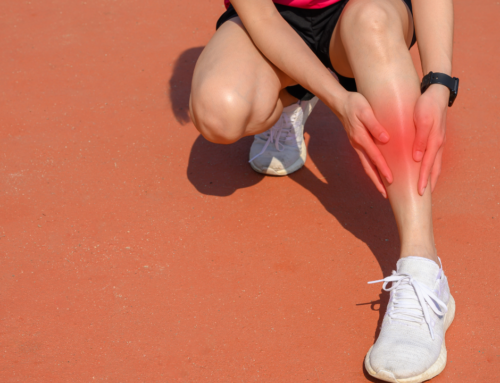Running is a form of exercise that appeals to people of all fitness levels. However, the repetitive nature of running can also make individuals susceptible to various injuries.
At Complete Physio, we know how frustrating it can be for runners when you pick up injuries, especially when training for an event. We want to make sure that you do not fall victim to any niggles that prevent you from doing the sport you love.
In this blog, we’ll explore common running injuries and the factors that contribute to their occurrence, and most importantly, provide some initial guidance on how to avoid running injuries through strategic training and exercises.
Understanding Common Running Injuries
Approximately one in every three recreational runners will have a running related injury at some stage of their running career.
Shin Splints (Medial Tibial Stress Syndrome)
Often characterised by pain along the inner edge of the shinbone, shin splints are commonly caused by overuse, improper footwear, or running on hard surfaces. If you have increasing pain on the shin, it is essential that you get assessed to ensure you don’t have a stress fracture.
Runner’s Knee (Patellofemoral Pain Syndrome)
This injury results in pain around or behind the kneecap and is frequently attributed to improper tracking of the kneecap, muscle imbalances, or overuse.
ITB (Iliotibial Band) Syndrome
The iliotibial band (ITB) is a thick band of tissue running from the outer hip to the outer knee. It can become inflamed and cause pain on the outer side of the knee. Overtraining, poor footwear, and muscle imbalances, especially weak hip and gluteal muscles contribute to this syndrome.
Plantar Fasciitis
This is a condition causing pain and inflammation of the plantar fascia, a band of tissue supporting the arch of the foot. It leads to heel pain, which is the main symptom, and may be caused by tight calf muscles and overpronation of the foot.
Achilles Tendinopathy (previously known as Achilles “Tendinitis”)
The Achilles tendon, connecting the calf muscles to the heel, can become sore and inflamed, causing stiffness and pain. It is usually due to over training, improper footwear, or muscle weakness in the calf.
Stress fracture
This is a bone injury caused by repeated stress over time rather than due to impact or direct trauma. Sufferers usually complain of increasing pain when exercising and little or no pain during resting. This can be a serious injury, especially if it is a femoral stress fracture and needs to be treated immediately by offloading the affected limb.
Strategies to Avoid Running Injuries
-
Proper Warm-up and Cool Down
Warm-up: begin each run with dynamic stretches and light jogging to increase blood flow and prepare your muscles for the upcoming activity.
Cool Down: conclude your running session with static stretches to improve flexibility and prevent muscle tightness and soreness.
-
Gradual Progression
One of the biggest mistakes is increasing your training too quickly. Avoid rapid increases in mileage or intensity to give your body time to adapt. Follow the ‘10% Rule’; limit your weekly mileage increases to 10% or less.
-
Quality Footwear
There are some very good running trainers on the market, and technology has progressed a lot over the last few years. However, the most important factor to consider when choosing a pair of trainers is whether or not they feel comfortable to you! If they do not feel immediately comfy, do not buy them!
It is important to get advice from a specialised running shop, and invest in a good pair of running shoes that provide proper support and fit your foot’s shape. Replace shoes regularly to maintain adequate cushioning. We often recommend you should change your trainers every 300-500 miles.
-
Cross-Training
Incorporate cross-training activities like cycling or swimming into your weekly training schedule, to reduce the impact on your joints and prevent overuse injuries.
-
Strength Training
This is probably the most important factor! Strength training will significantly reduce your risk of developing an injury and will also boost your fitness and performance. Focus on strengthening key muscle groups, including the core, hips, and lower limbs.
-
Flexibility Exercises
Include dynamic and static stretching in your routine to improve flexibility and prevent muscle imbalances.
-
Proper Running Form
Maintain a relaxed posture and ensure your stride is comfortable. There are many factors that will influence whether you are a “heel striker”, “mid foot” runner, or a “toe runner”. Consider having a gait analysis (running assessment) by a specialist physiotherapist, to identify and correct any inefficiencies. Technique can be key to enhancing running efficiency and performance, and reducing your risk of injury.
-
Rest and Recovery
It is really important not to over-train. Allow for adequate rest days in between your runs, and break up your training schedule with some lower impact exercises like yoga and pilates. Listen to your body and make sure you get adequate sleep and nutrition which are both crucial for recovery.
-
Terrain Variation
Mix up your running surfaces, alternating between softer surfaces like trails and harder surfaces like pavement helps reduce repetitive stress on the same muscles and joints. This can really help to prevent getting a stress fracture, a runner’s nightmare!.
-
Listen to Your Body
Pay attention to any niggles or signs of pain, discomfort, or fatigue. Ignoring these signals will only lead to trouble and you will end up with more serious injuries that take longer to heal. We always say if you are experiencing the same pain on two consecutive runs or have a pain that is getting worse every time you run, then you should seek an assessment with one of our expert physiotherapists.
How can Physiotherapy help me achieve my best?
At Complete Physio we see thousands of runners each year, and have helped countless people train for their running events, whether that be their first 5k or their 20th Marathon, or even an ultra marathon!
We have a team of exceptional physiotherapists, many of whom are very experienced and dedicated runners themselves. We also have a team of podiatrists, pilates instructors, massage therapists and strength and conditioning coaches, and we believe in an holistic approach to injury prevention and management.
Your physiotherapist can provide training advice and techniques which will get you back on your feet after injury, as well as supporting you through your training, and helping prevent any further injuries.
Each runner and their needs and goals are different, so an individualised program of specific stretches and strengthening exercises can be tailored to ensure that you remain in tip top shape and injury free.
Physiotherapy aims to target specific deficits and help improve strength, balance, core control, endurance and flexibility, helping you to boost your running performance.
Conclusion – Stride Don’t Strain!
Running injuries are not inevitable, and with a proactive approach to training and exercise, and by seeking some expert advice, you can significantly reduce the risk of encountering them. Incorporate a well-rounded fitness regimen, prioritise proper form and footwear, and listen attentively to your body’s signals. By adopting these strategies, you’ll not only enjoy injury-free running but also elevate your overall fitness and well-being.
Q&A: Running Injury Prevention
Q1: How can I tell if I have shin splints or a stress fracture in my shin?
A: Shin splints typically present as a dull, aching pain along the inner edge of the shinbone during or after running, while stress fractures often cause sharper pain that increases with activity and decreases with rest. If you’re experiencing increasing pain in your shin, especially with weight-bearing activities, it’s crucial to seek assessment from a healthcare professional to rule out a stress fracture.
Q2: What are the signs of overtraining and how can I avoid it?
A: Signs of overtraining include persistent fatigue, decreased performance, increased susceptibility to illness, and chronic muscle soreness. To avoid overtraining, incorporate rest days into your training schedule, vary your workouts to prevent monotony, and listen to your body’s signals of fatigue or discomfort. A well-balanced training plan should include periods of active recovery and adequate rest to optimise performance and reduce the risk of injury.
Q3: How do I know if my running shoes are the right fit for me?
A: Properly fitting running shoes should feel comfortable and supportive from the moment you put them on. Ensure there’s enough room in the toe box to wiggle your toes, and that the shoes provide adequate arch support and cushioning. Visit a specialised running shop for a professional fitting, and consider replacing your shoes every 300-500 miles to maintain optimal support and cushioning.
Q4: Can strength training really help prevent running injuries?
A: Absolutely! Strength training plays a crucial role in injury prevention by improving muscular strength, stability, and endurance. Targeting key muscle groups such as the core muscles, glutes, quads, hamstrings and calves can help correct muscle imbalances, enhance biomechanical efficiency, and reduce the risk of overuse injuries. Incorporate strength training exercises into your routine at least 2-3 times per week to reap the benefits of injury prevention and improved performance.
Q5: How can physiotherapy help me if I’ve already sustained a running injury?
A: Physiotherapy can be instrumental in the rehabilitation and recovery process following a running injury. A qualified physiotherapist, with experience in treating runners and running injuries, will be able assess your condition, identify contributing factors, and develop a personalised treatment plan to address your specific needs and goals. Treatment may include manual therapy, targeted exercises, biomechanical analysis, and education on injury prevention strategies. By addressing underlying deficits and promoting optimal healing, physiotherapy will have a hugely positive effect on your return to running.
Don’t let pain hold you back, book now!





